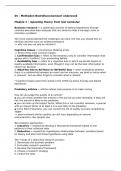SV - Methoden Bedrijfseconomisch onderzoek
Module 1 : repeating theory from last semester
Business research = a systematic process of testing hypotheses through
carefully executed data analyses that are aimed to help a manager solve or
minimize a problem
The more unprecedented the challenges you face, the less you should rely on
intuition and the more on evidence/research
-> why can you not rely on intuition?
Cognitive biases = unconscious thinking errors
-> three of the most common biases:
1. Confirmation bias = refers to the tendency only to consider information that
agrees with ("confirms") our preexisting beliefs
2. Availability bias = refers to a cognitive bias in which we decide based on
readily available information, even though it may not be the best information to
inform our decision
3. What-You-See-Is-All-There-Is (WYSIATI) bias = when evaluating whether
there is a relationship between an event and an outcome, we tend to notice what
is 'present', but we often forget to consider what is 'absent'
* Cognitive biases were first coined in the 1970s by Amos Tversky and Daniel
Kahneman
Predatory articles = articles whose sole purpose is to make money
How do you judge the quality of an article?
▪ you can check whether the articles in the journal are peer-reviewed. If they are
not, the journal is likely to be predatory.
▪ you can look up the impact factor. While this is not a perfect measure, a journal
with an impact factor of at least 1.0 is less likely to be predatory
▪ in the field of business, you can consult the list of quality journals compiled by
TISEM
-> peer-reviewed articles quality can still vary depending on several
characteristics, like sample size
Two research approaches:
1. Inductive = researches develop a theoretical framework based on the
patterns in their collected data
2. Deductive = researches hypothesize relationships between variables based
on theory and then test these hypothesis using data
The 7 steps of a deductive research process:
1. Demarcate the business problem
2. Formulate research questions
3. Develop the theoretical framework
4. Choose a research strategy
5. Collect the data
,6. Analyse the data
7. Write a report
STEP 1 : Demarcate the business problem
A business problem occurs when a company encounters a threat or an
opportunity
-> it needs to be narrowed down (demarcated) before you can research it
You should only research a problem if its relevant, two types of relevance:
1. Academic relevance = the study should contribute to the literature
▪ new topic,
▪ same topic but new context,
▪ integrate scattered findings,
▪ reconcile conflicting findings
2. Managerial relevance = when one or more parties benefit from having the
problem researched
▪ managers in a company, an industry, or multiple industries
▪ end users
▪ public policymakers
STEP 2 : Formulate research questions
Problem statement = the central question that a research study aims to
answer
-> a good problem statement is:
▪ an open-ended question (start the question with: ‘what’, ‘how’, or ‘to what
extent’)
▪ that identifies the study’s unit of analysis, and
▪ that is expressed in terms of variables and relationships
Unit of analysis = the entity that the study wishes to say something about, the
focus of the study
-> examples (usually called the subjects) :
▪ individuals
▪ firms
▪ groups (industries, boards of directors, alliances, etc.)
▪ things (products, brands, shares, etc.)
▪ geographical units
Unit of analysis can also be at different aggregation levels:
1. Country
2. Industry
3. Firm
4. Brand
5. Consumer
-> Consumer is the least aggregated, country is the most aggregated
Variables can vary in three ways:
1. Across subjects
2. Over time
, 3. Across subjects and over time
-> variables need to have at least two different values within the study,
otherwise it is called a constant
Problem statements expresses the relationship between at least two variables
-> oftentimes there is a third variable which influences the relationship between
two variables, this is called the moderating effect
Including all moderating effects in a problem statement can make the question
very complex, that is why they are often included in research questions
Possible framework for a background section in a research study:
1. A background section starts by framing the research
2. The problem is then identified in the next paragraph
3. The next step is formulating the study’s aim: to address the identified problem.
The paragraph may then elaborate on the aim of the study to arrive at the
problem statement or research questions
4. The following (two or more) paragraphs highlight the academic and managerial
relevance of the research
5. The background section sometimes concludes by indicating the outline of the
study
STEP 3 : Develop the theoretical framework
The theoretical model includes:
▪ providing a literature review (= a condensed overview of the key studies on
the topic)
▪ presenting/visualizing the conceptual model (= a summary of the new study,
including the variables which are used, why they are used and how they relate to
each other)
▪ formulating expectations (research hypotheses) for the relationships between
the variables.
Different types of variables:
1. Dependent (= the variable we try to explain or predict) (Y)
2. Independent (= affects the independent variable positively or negatively) (X)
3. Mediating (= explains the process that underlies the relationship between X
and Y)
4. Moderating (= changes the strength or direction of the relationship between
X and Y)
-> can also have an effect on the dependent variable, Y
5. Control (= not the focus of the study, but has an important effect on the
variables which cannot be ignored)
-> is included within the study to filter out its effect, usually kept constant
Relationships between variables:
1. Main effect (= the effect you are researching)
2. Moderating effect (= affects a main effect)
The key to writing a good literature review:





